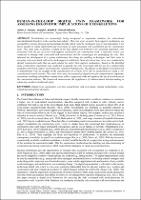Chapter Human-in-the-Loop Digital Twin Framework for Assessing Ergonomic Implications of Exoskeletons
| dc.contributor.author | Akanmu, Abiola | |
| dc.contributor.author | Afolabi, Adedeji | |
| dc.contributor.author | Okunola, Akinwale | |
| dc.date.accessioned | 2024-04-02T15:47:11Z | |
| dc.date.available | 2024-04-02T15:47:11Z | |
| dc.date.issued | 2023 | |
| dc.identifier | ONIX_20240402_9791221502893_91 | |
| dc.identifier.issn | 2704-5846 | |
| dc.identifier.uri | https://library.oapen.org/handle/20.500.12657/89122 | |
| dc.description.abstract | Exoskeletons are increasingly being recognized as ergonomic solutions for work-related musculoskeletal disorders in the construction industry. However, users of active back-support exoskeletons are susceptible to various physical and psychological risks, which could be exoskeleton type-or task-dependent. A test bed is needed to enable deployment and assessment of risks associated with exoskeleton-use for construction tasks. This study aims to develop a human-in-the-loop digital twin framework for assessing ergonomic risks associated with the use of active back-support exoskeletons for construction work. A literature review was conducted to identify risks associated with exoskeletons and the technologies for quantifying the risks. This informed the development of a system architecture describing the enabling technologies and their roles in assessing risks associated with active back-support exoskeletons. Semi-structured interviews were conducted to identify construction tasks that are most suitable for active back-support exoskeletons. Based on the identified tasks, a laboratory experiment was conducted to quantify the risks associated with the use of a commercially available active back-support exoskeleton for carpentry framing tasks. The efficacy of the digital twin framework is demonstrated with an example of the classification of exertion levels due to exoskeleton-use using a 1D-convolutional neural network. The study showcases the potential of digital twins for comprehensive ergonomic assessment, enabling stakeholders to proactively address ergonomic risks and optimize the use of exoskeletons in the construction industry. The framework demonstrates the significance of evidence-based decision-making in enhancing workforce health and safety | |
| dc.language | English | |
| dc.relation.ispartofseries | Proceedings e report | |
| dc.subject.classification | thema EDItEUR::U Computing and Information Technology | |
| dc.subject.other | Digital twin | |
| dc.subject.other | ergonomics | |
| dc.subject.other | exertion | |
| dc.subject.other | exoskeletons | |
| dc.subject.other | risk assessment | |
| dc.subject.other | sensing technologies | |
| dc.subject.other | work-related musculoskeletal disorders | |
| dc.title | Chapter Human-in-the-Loop Digital Twin Framework for Assessing Ergonomic Implications of Exoskeletons | |
| dc.type | chapter | |
| oapen.identifier.doi | 10.36253/979-12-215-0289-3.121 | |
| oapen.relation.isPublishedBy | bf65d21a-78e5-4ba2-983a-dbfa90962870 | |
| oapen.relation.isbn | 9791221502893 | |
| oapen.series.number | 137 | |
| oapen.pages | 12 | |
| oapen.place.publication | Florence |

